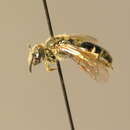en
names in breadcrumbs


Plateaux-Quénu (2008) reviews the social biology of this European species. It constructs nests that are tunnels onto the ground, opening on to a cavity enclosing a cluster of brood cells. This species was considered to be solitary, but the author provides observations demonstrating eusociality in an observation nest: as in many temperate sweat bees, future reproductives emerge in the late summer, mate with males, and then overwinter to initiated new nests the following spring (the males die before winter). Plateaux-Quénu (2008) placed four overwintered females in a cage with nesting substrate (soil). One female invaded the nest of another which already had three cells. The invader then assumed a worker role, while the original reproductive assumed a queen role, making the colony semi-social (reproductive division of labor among females of the same generation). This worker provisioned the queen’s offspring with pollen, and the females born from this first brood became workers. A solitary female in another cage also raised a female worker brood. The experiment ended before the worker brood could provision a late summer reproductive brood.